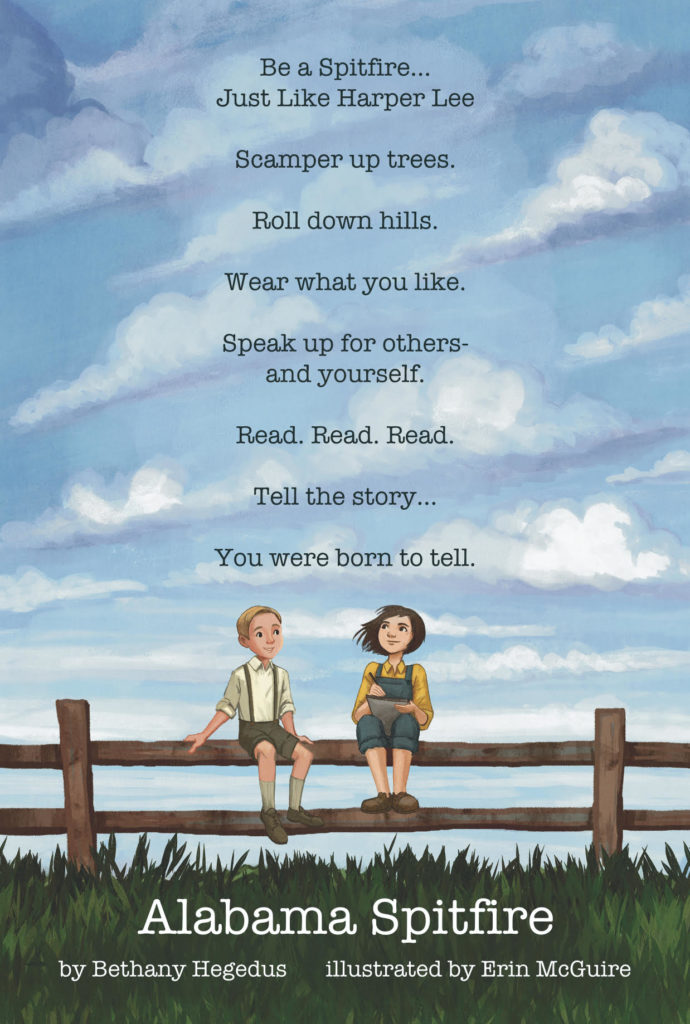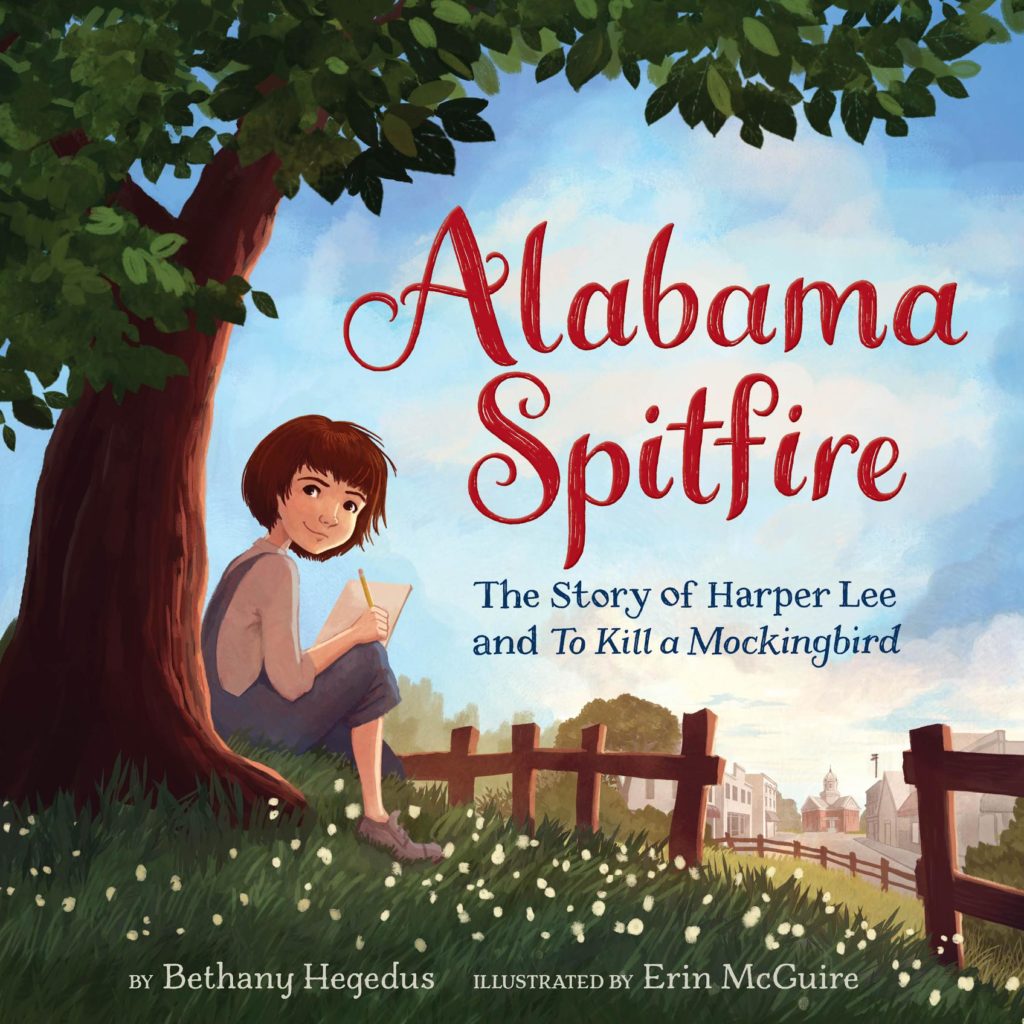Author Bethany Hegedus is known for her inspiring, touching and thought-provoking presentations to both adults and children for her GRANDFATHER GANDHI picture books. Now she has a brand new picture book out, ALABAMA SPITFIRE: THE STORY OF HARPER LEE AND TO KILL A MOCKINGBIRD, and is creating new presentations to extend this wonderful story. We thought it would be interesting to get a behind-the-scenes look at how Bethany develops her programming and are thrilled that she agreed to pull back the curtain. Here’s a guest post from Bethany Hegedus on tips for designing an inspiring school visit presentation…

You either have a new book out or your first book out and it’s time to think about school visits. Yikes! How can you present your book in an engaging way to a room of 30 kids or an auditorium filled with 500 or more? What do you share from the process? How can you showcase your book’s themes?
Ah, first take a deep breath. Your job as an author/presenter is to inspire your audience. It’s about them—not about you.
After four years of presenting the two GRANDFATHER GANDHI books, with themes around anger, non-violence, waste and recycling, I have a new book out, one that doesn’t deal with any of those themes. ALABAMA SPITFIRE: THE STORY OF HARPER LEE AND TO KILL A MOCKINGBIRD focuses on Nelle Harper Lee’s spitfire streak, her childhood friendship with Truman Capote—another of America’s great writers—and her grit and gumption in becoming an author and telling the story that she was born to tell and creating characters who the world has come to love and own, like no other author.
How did I approach designing inspiring presentations? Here’s how:
- Find and focus on what will interest your audience. Make connections to them.
 Nelle Harper Lee was a spitfire. Today’s kids are spitfires too. What makes a spitfire? Speaking up for yourself and others. Wearing what you want to wear. How can kids be like Harper Lee? The illustrator of ALABAMA SPITFIRE, Erin McGuire, created an image for our #BeASpitfire campaign, encouraging readers to “live lives of their own design”—just like Harper Lee.
Nelle Harper Lee was a spitfire. Today’s kids are spitfires too. What makes a spitfire? Speaking up for yourself and others. Wearing what you want to wear. How can kids be like Harper Lee? The illustrator of ALABAMA SPITFIRE, Erin McGuire, created an image for our #BeASpitfire campaign, encouraging readers to “live lives of their own design”—just like Harper Lee.
- Find and focus on what will interest educators. Make connections to the classroom.
ALABAMA SPITFIRE is about a writer—and not just any writer—but America’s favorite writer. What did she read as a child? Sherlock Holmes mysteries. Did she write as a child? She sure did. Nelle and Truman wrote pot-boiler mysteries based on their small-town neighborhood’s goings on. Old Mrs. Busybody and The Fire and the Flame were two of their titles. On my school visits, I am going to do mini or extended writing exercises with students based on their observations of their hometowns. Will there be a budding Harper Lee or Truman Capote in the audience? Perhaps. But even more than inspiring America’s next great novelists, I hope to partner with educators to show writing as a skill we can all use. We all have something to say. Writing is our way to say it. And share it.
- Focus on the struggle. Yours, your characters’, and/or your subjects’.
Understanding resilience, which society is focusing on—rightly—as a way to ensure future success is key. I share with audiences young and old, my ten+ year journey to publishing my first novel. My thirteen-year journey to publishing GRANDFATHER GANDHI, and now I can share with them the decades Nelle Harper Lee took in perfecting her craft, writing short story after short story before landing an agent. Then switching to a longer form: the novel and writing and revising, and revising more to create a book she thought no one would really take notice of that went on to win the Pulitzer and become one of the most beloved books of all time.
- Be yourself. Be real. And allow your audiences to be real.

I was in Virginia speaking after the white supremacist marches and violence this last summer. One girl, the only African-American student in a packed auditorium, who I had called on many times, said at the end of the presentation that she was “mad at that man that killed that woman, running her over with his car.” I told her she had a right to be mad. I was mad. Arun Gandhi was mad…and if still living Dr. King and Mahatma Gandhi would be mad too. Our anger was ok. It pointed to something unjust and unfair had occurred. Now, what were we going to do with our anger? Lash out at someone else? Lash inward at ourselves? Or could we talk about our anger and let it move us to action? I shared how the terrorist attacks on 9/11, of which I am a survivor, led me to ask Arun Gandhi to work with me.
What could this student do? I invited her to speak with me after the presentation and we had a long talk about her difficulties being “the only black girl” in the 3rd grade, and how the man who killed that woman in Virginia were white—just like I was. We talked about what being an ally meant and how hard it was to figure out who was our ally or not.
Watch Bethany get real and talk about her own inspiration from Harper Lee and To Kill a Mockingbird and about Harper Lee and Truman Capote’s beginnings as young writers.
Thank you, Bethany!
Read more about Bethany Hegedus and her books and presentation on her speaker page.
